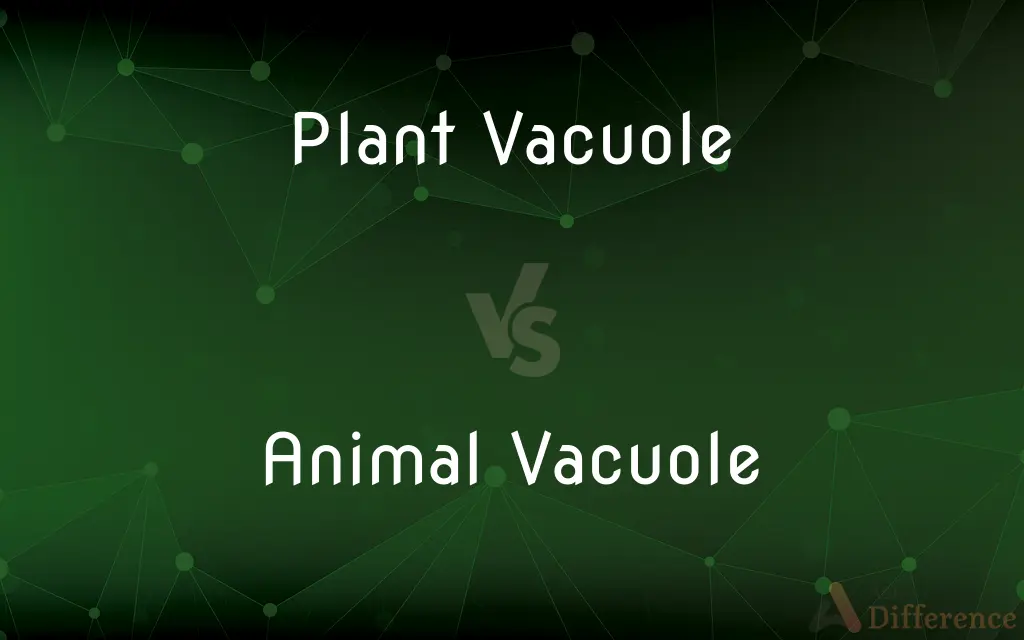Plant Vacuole vs. Animal Vacuole — What's the Difference?
By Urooj Arif & Fiza Rafique — Published on October 22, 2024
Plant vacuoles are large, central organelles regulating turgor pressure, storage, and waste disposal, while animal vacuoles are smaller, transient, and involved in various processes like endocytosis and exocytosis.

Difference Between Plant Vacuole and Animal Vacuole
Table of Contents
ADVERTISEMENT
Key Differences
Plant vacuoles play a pivotal role in maintaining cell structure and pressure, often occupying more than 30% of the cell's volume. They store nutrients, waste products, and pigments, and their osmotic balance is crucial for plant rigidity and growth. The presence of a large central vacuole is a defining feature of mature plant cells, contributing to cell expansion and providing structural support.
Animal vacuoles, on the other hand, are smaller and more numerous, with functions varying from storage and transport to the digestion of cellular waste and foreign materials. Unlike their plant counterparts, animal vacuoles do not play a significant role in maintaining cell shape or size. They are involved in processes such as endocytosis, where cells engulf external particles, and exocytosis, the expulsion of waste or secretory products.
The composition of plant vacuoles includes a solution of enzymes, ions, and molecules like sugars and amino acids, surrounded by a membrane called the tonoplast. This composition supports their role in storage, metabolism, and detoxification. In contrast, animal vacuoles contain a variety of substances depending on their specific function, including enzymes for breaking down macromolecules in lysosomes, a type of animal vacuole.
The formation and function of vacuoles also differ between plants and animals. Plant vacuoles form from the merging of smaller vacuoles and play a key role in growth by absorbing water and increasing cell size. Animal vacuoles, however, often form at the site of need, such as phagocytic vacuoles in immune response, highlighting their dynamic nature in animal cells.
The differences in vacuole size, function, and formation reflect the distinct life strategies of plants and animals. Plant vacuoles are essential for storage and structural support, facilitating growth and survival in stationary conditions. Animal vacuoles adapt to more varied and active lifestyles, participating in defense, nutrient processing, and waste management.
ADVERTISEMENT
Comparison Chart
Size & Presence
Large and central, often one per cell
Smaller and numerous, multiple per cell
Primary Functions
Turgor pressure, storage, waste disposal
Endocytosis, exocytosis, digestion
Structural Role
Provides cell rigidity and supports growth
Does not contribute to cell rigidity
Composition
Enzymes, ions, sugars, amino acids
Varied, includes enzymes for digestion
Formation
From merging of smaller vacuoles
Form at the site of need, e.g., phagocytosis
Compare with Definitions
Plant Vacuole
Large central vacuoles help in plant waste disposal.
Toxic byproducts of metabolism are sequestered in the vacuole.
Animal Vacuole
Animal vacuoles process ingested materials.
Phagocytic vacuoles in white blood cells engulf pathogens.
Plant Vacuole
Involved in the storage of important nutrients.
Vacuoles in seeds store proteins for germination.
Animal Vacuole
Play a role in cellular waste removal.
Exocytosis vacuoles expel waste products from the cell.
Plant Vacuole
Plant vacuoles store water and solutes, maintaining cell turgor.
The vacuole in a guard cell helps open and close stomata.
Animal Vacuole
Participate in cellular communication processes.
Secretory vacuoles release neurotransmitters at nerve endings.
Plant Vacuole
They contain pigments affecting flower and fruit color.
Anthocyanins in vacuoles give petals their red color.
Animal Vacuole
Assist in maintaining internal cellular environment.
Contractile vacuoles in protozoa expel excess water.
Plant Vacuole
Contribute to cell enlargement and plant growth.
Water absorption by the vacuole increases cell size, aiding growth.
Animal Vacuole
Involved in storage and transport within cells.
Vacuoles transport enzymes to sites of intracellular digestion.
Common Curiosities
Can animal cells have large vacuoles like plant cells?
Typically, no. Animal cells contain smaller, more transient vacuoles with different functions.
How do plant vacuoles contribute to turgor pressure?
By storing water and solutes, plant vacuoles exert an internal pressure that keeps cells firm.
What role do vacuoles play in animal cells?
Animal vacuoles are involved in digestion, storage, waste removal, and cell processes like endocytosis and exocytosis.
Why are vacuoles important for plants?
Vacuoles store nutrients and waste, maintain cell pressure, and play a critical role in growth and defense.
What distinguishes plant vacuoles from animal vacuoles?
Plant vacuoles are large, central organelles for storage and support, while animal vacuoles are smaller, involved in various cellular processes.
Are animal vacuoles temporary structures?
Yes, many animal vacuoles form temporarily to fulfill specific functions like digestion or waste expulsion.
What is the significance of vacuole pigments in plants?
Pigments in plant vacuoles, like anthocyanins, contribute to the coloration of flowers and fruits, attracting pollinators and aiding in reproduction.
How do animal vacuoles differ in function from lysosomes?
While lysosomes are a type of animal vacuole focused on digestion, other animal vacuoles perform functions like storage, waste removal, and water balance.
Do all plant cells have a large vacuole?
Most mature plant cells have a large central vacuole, but size and number can vary depending on cell type and development stage.
How do vacuoles affect plant cell size?
Vacuoles absorb water, causing the cell to expand and increase in size, which contributes to plant growth.
What substances are stored in plant vacuoles?
Plant vacuoles store water, enzymes, ions, sugars, amino acids, and sometimes pigments or toxic substances.
Do all animal cells contain vacuoles?
Most animal cells contain vacuoles at some point, but their presence and function can vary widely depending on the cell type and its current activities.
How do vacuoles participate in plant defense?
Plant vacuoles can contain defensive compounds that deter herbivores or pathogens, playing a role in the plant's immune response.
Can vacuoles repair damaged plant tissue?
Vacuoles contribute to cellular maintenance and can isolate harmful materials, but direct repair of damaged tissue involves additional cellular processes.
Share Your Discovery

Previous Comparison
Refined Shea Butter vs. Unrefined Shea Butter
Next Comparison
Mutually Exclusive Event vs. Independent EventAuthor Spotlight
Written by
Urooj ArifUrooj is a skilled content writer at Ask Difference, known for her exceptional ability to simplify complex topics into engaging and informative content. With a passion for research and a flair for clear, concise writing, she consistently delivers articles that resonate with our diverse audience.
Co-written by
Fiza RafiqueFiza Rafique is a skilled content writer at AskDifference.com, where she meticulously refines and enhances written pieces. Drawing from her vast editorial expertise, Fiza ensures clarity, accuracy, and precision in every article. Passionate about language, she continually seeks to elevate the quality of content for readers worldwide.














































